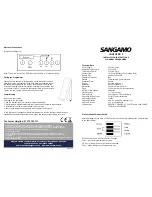
f.
Intramessage (within messages) timeout: 500ms. There should be no gaps longer than 500ms
between bytes of a message.
g.
The thermostat takes a maximum of 30ms to set a register. When setting registers, the thermostat
will reply after it has written the registers to its internal EEPROM. The host may transmit another
message immediately after the thermostat completes its reply. If setting registers with a broadcast
message, the thermostat will not reply, and it will not enable its receiver until after it has written
all registers. Therefore, when using a broadcast message, the host must wait at least 30ms per
register set before starting any subsequent message. A worst case example is to send a broadcast
message that sets 14 registers. The host must wait 14*30ms = 420ms before sending any other
message.
THERMOSTAT ERROR HANDLING AND BIT TIMING:
a.
Error handling: If a framing error occurs (no start or stop bit where one was expected) or an
incorrect checksum is detected, the thermostat ignores the remainder of the message. The
thermostat will continue to receive and ignore bytes until an intramessage timeout occurs.
b.
Bit timing: The center of each bit of the reply occurs at integer intervals of the beginning of the
start bit of the last byte in the message that caused the reply. The thermostat requires anywhere
from 0 to 420ms to format a reply and begin sending it. Therefore, a reply could begin anywhere
from 0.5 to 42.5 bit times after the end of the stop bit of the message that caused the reply at 100
baud. However, the reply will always start on .5 bit time intervals (1.5, 3.5, etc.).
Note: this bit timing is compatible with all PC serial ports, and any other port with a hardware Universal
Asynchronous Receiver Transmitter (UART). It also allows communications with a software UART using
input/output pins, because the bits of the reply are synchronized with the transmitter's bit clock.
MESSAGE TYPES
a. Host to Thermostat
0: Poll for register(s)
This message requests from one to 14 registers be returned in a Data message. The thermostat
will reply with the data or a negative acknowledge.
RA
DL/MT
2 / 0
DATA
first register address, number of registers (1-14)
CKSUM
Valid response message types:
Data
Negative Acknowledge (message received but invalid register address)
1: Set Register(s)
This message tells the thermostat to set one to 14 consecutive registers starting with the "start
register address". The number of registers to set with the data bytes following the "start
register address" is determined by subtracting one (1) from the data length DL. If the start
register is an ASCII string register, the data length (DL) is ignored and the ASCII string is
written. If an ASCII string register is the start register, the DATA is the string followed by an
End Of text (0x03) to signify the checksum is the next byte.
Copyright © 2008 Home Automation, Inc.
All Rights Reserved
Page 3
Summary of Contents for Omnistat2 RC-1000
Page 2: ......
Page 17: ...Copyright 2008 Home Automation Inc All Rights Reserved Page 15 ...
Page 18: ......




































